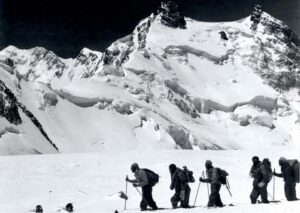The earliest European exploration of Africa took place thousands of years before Prince Henry the Navigator‘s famous 14th-century exploration of the West African coast. At the height of the Roman Empire, numerous individuals ventured into the yet uncharted continent.
Cornelius Balbus expedition
In 19 BC, Roman politician Lucius Cornelius Balbus led the first Roman expedition into the Sahara. The man was a seasoned veteran of Julius Caesar’s grueling civil wars and a dedicated servant to his successor, Augustus. Despite not being a native Roman (he was originally from southern Spain), he was well trusted by the Roman nobility.
Augustus desired to expand the empire and appointed Balbus to lead a military campaign against the Garamantes, a Berber civilization that resided in modern-day Libya. Romans portrayed the Berbers as aggressive and plunderous when, in reality, they were skilled agriculturists and engineers.

A statue depicting Cornelius Balbus. Photo: Pinterest
This mission took Balbus and a legion of soldiers from Libya to Algeria, and as far as Mali. Along the way, they crossed the Tassili, Hoggar, some parts of the Atlas Mountains, and reached the Niger River. He succeeded in defeating the Garamantes.
To honor Balbus’s achievement, Augustus granted him a “triumph”, an elaborate public ceremony that legitimized a military commander’s campaign success. The ceremony involved dressing Balbus in a laurel and a purple and gold toga. His face was painted red and he was paraded around the city in a chariot. A group of stone tablets that recorded such auspicious events, called the Fasti Triumphales, had Balbus’s triumph as the last written record.
Suetonius Paulinus expedition
In 41 AD, another Roman general led an expedition to the Atlas Mountains. The ancient historian Pliny the Elder wrote that Gaius Suetonius Paulinus was the first Roman to lead an army over the mountain chain. Paulinus was pursuing the Mauri, who were invading a Roman-occupied region at the time.
Despite his military duties, Paulinus reported back on the alien terrain, its plant and wildlife. Pliny the Elder states that the “regions at the base of the range are filled with dense and lofty forests of trees of an unknown kind, with very tall trunks remarkable for their glossy timber free from knots, and foliage like that of Cypress except for its oppressive scent”. Accounts describe Paulinus as completely enraptured by the region.

Suetonius Paulinus. Photo: Ad Meskens
Pliny the Elder wrote that a trek to one summit took Paulinus and the army ten days. After, they continued on to the Ger River. Expedition members described the oddity of snow-covered desert mountains and the presence of black sands alongside thick forests. Pliny the Elder claimed the party reached as far as Mauritania and Senegal.
In his later years, Paulinus gained notoriety by defeating Queen Boudica in Britain in 61 AD.
Hanno the navigator
Carthage was one of the most important cities in the ancient world. It was a vital trading center and the Phoenicians who founded the city often looked overseas for new trading routes and opportunities. They saw Africa as the perfect place to strengthen Carthaginian trading superiority.
Hanno the Navigator was a Carthaginian explorer who led a naval expedition along Africa’s west coast in the fifth-century BC. His job was to take his 60 ships and 30,000 men along the west coast, establish Phoenician colonies, and continue pushing the Phoenician agenda as far as he was able.
He passed the Strait of Gibraltar (then called the Pillars of Hercules) and explored the coasts of Morocco, Libya, Senegal, and possibly Guinea, Sierra Leone, and Liberia.
Hanno wrote extensively, describing hostile tribes, gorillas, and volcanoes pouring into the sea. There remains some debate among historians as to how far south he sailed. His accounts vaguely note a place called “Kerne”, another place he called the “Horn of the West”, and even the “Horn of the South”.
Hanno did his duty, establishing colonies along his route. Though the expedition went well, supplies eventually began to run low, forcing him to return to Carthage.
The lost expedition of Cambyses II
Cambyses II was the son of the renowned Persian emperor, Cyrus the Great. With big shoes to fill, Cambyses II wanted to legitimize his rule. After invading Egypt in 525 BC, he conquered the cities of Memphis, Sais, and Luxor. However, he did not receive the welcome he expected. The priests of Amun were thoroughly against his conquest, prompting the impulsive ruler to dispatch an intimidating army of 50,000 to Siwa Oasis.
Cambyses II wanted the army to stamp out resistance and secure slaves. He did not personally accompany his men. The army was supposedly wiped out by a deadly sandstorm somewhere in the Western Desert. The historian Herodotus is the main authority on what happened, describing the incident thus: “a wind arose from the south, strong and deadly, bringing with it vast columns of whirling sand, which entirely covered up the troops and caused them wholly to disappear”.
Historians have tried to determine if the army perished by a sandstorm or by other means. A powerful enough sandstorm to wipe out an entire army would be exceptionally rare. Some suggest they may have died in battle. In 2009, archaeologists found bones, weapons, jewelry, and other artifacts near a famous stronghold once belonging to a rebel named Petubastis III. They believe these items belonged to the lost army. If true, it would suggest that Cambyses II’s army was defeated by these rebel forces and the story of a sandstorm was a cover-up to protect Persia, and Cambyses II’s, image.






